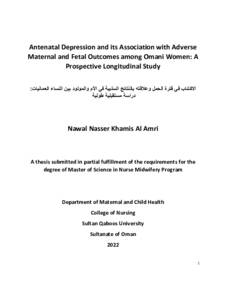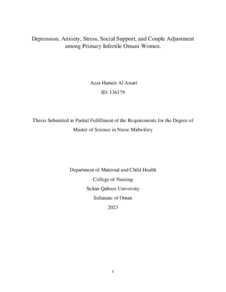Document
Antenatal depression and its association with adverse maternal and fetal outcomes among Omani women : a prospective longitudinal study.
Other titles
الاكتئاب في فترة الحمل وعلاقته بالنتائج السلبية في الأم والمولود بين النساء العمانيات : دراسة مستقبلية طولية
Publisher
Sultan Qaboos University.
Gregorian
2022
Language
English
Subject
English abstract
Background: Antenatal depression is a significant form of depression that can arise during
pregnancy, is characterized by mood disorders, and is considered as one of the main reasons for
maternal mortality and morbidity. Depression during pregnancy can result in premature birth, a
lower birth weight, preeclampsia and many other comorbidities for mother and babies. In Oman,
maternal depression is not routinely screened for during pregnancy nor after childbirth.
Aim: The aim of this study is to explore the prevalence of depression among Omani mothers
during the antenatal and to determine the adverse birth outcomes associated with antenatal
depression.
Method: A longitudinal design was used to achieve the aim of the current study. Omani pregnant
women (n=263) from Al Dhahira region were screened for antenatal and postnatal depression,
using the Edinburg Postnatal Depression Scale (EPDS). The questionnaire was administered twice
per participant; during antenatal visits, and again at the postpartum follow-up visit (usually at week
2 and 6 postpartum). Women's sociodemographic, economic, and obstetric characteristics were
reported followed by the EPDS questionnaire. All parts of the instrument were self-administered
except for the birth outcomes which were collected from the medical records. The hypotheses were
tested using independent t-test, Chi-square, and ANOVA. Characteristics of the participants using
descriptive analyses (mean, standard deviation, frequency and percentage) were tested and
described before conducting correlation analysis to examine the associations between antenatal
depression and adverse birth outcomes (controlling for sociodemographic and obstetric
confounders).
Result: The prevalence of antenatal depression was 22.4% of the mothers and the postnatal
depression in 25.9%. The mean age for mothers who had depression was 30 (SD=4.8) with no
significant difference from the other groups. Furthermore, among mothers who had depression;
61.0% were housewives, 62.7% had middle monthly income of 500-1000 RO/month, and 25.4%
had lower monthly income (<500 RO/month). Besides, 54.2% of mothers with depression had
higher education, 55.9% lived in simple family construction, and 86.4% were physically inactive.
Moreover, among the group of mothers who had depression; 25.4% did not plan their pregnancies
and 55.9% were not using contraception before the current pregnancy. The antenatal depression
was significantly and positively associated with postnatal depression (P<0.01) but not with the
other adverse birth outcomes (gestational age at delivery (P= 0.18), Apgar score 1 minute after
birth (P=0.30), Apgar score 5 minutes after birth (P=0.15), weight of the infant at birth (P=0.13),
onset of delivery (P= 0.72 ),initiation of breastfeeding (P= 0.81), intrapartum complications (P=
0.19), type of induction (P=0.47), mode of delivery (P=0.92 ) and perineum status (P=0.61).
Conclusion: A considerable rate of pregnant mothers had antenatal depression which was slightly
increased after childbirth. Furthermore, the antenatal depression was only associated with the
postnatal depression and not the other adverse outcomes. The findings of this study highlight the
urgent need for standardization of depression screening of all pregnant women in the Sultanate. It
also calls for a population-based study to investigate the prevalence of depression in pregnant
women and in the first year following childbirth. Furthermore, midwives and other health care
professionals who provide services to pregnant women should be aware of the high prevalence of
antenatal depression. Hence, training may be required to ensure midwives' competency in
psychosocial assessment, including the use of reliable screening tools (e.g., the EPDS), as well as
the management of women suffering from antenatal and/or postnatal depression.
Member of
Resource URL
Arabic abstract
المقدمة: اكتئاب الحمل هو شكل هام من أشكال الاكتئاب يمكن أن يظهر أثناء الحمل، ويتميز باضطرابات المزاج والقلق، ويعتبر أحد الأسباب الرئيسية لوفيات الأمهات واعتلالهن. يمكن أن يؤدي الأكتئاب أثناء الحمل إلى الولادة المبكرة وانخفاض وزن الجنين عند الولادة وتسمم الحمل والعديد من الأمراض المصاحبة الأخرى لألم والرضع. في عمان، لا يتم فحص اكتئاب الأمهات بشكل روتيني أثناء الحمل أو بعد الولادة. وتحديد للوالدة قبل ما فترة خلال العمانيات الأمهات بين الأكتئاب انتشار مدى استكشاف هو الدراسة هذه من الهدف :الهدف الولادة قبل بالأكتئاب المرتبطة السلبية الولادة نتائج الطريقة: تم استخدام تصميم طولي لتحقيق هدف الدراسة الحالية. تم فحص النساء العمانيات الحوامل )ن = 263( من منطقة الظاهرة الكتئاب ما قبل وبعد الولادة، باستخدام مقياس إيدينبورغ لالكتئاب بعد الولادة )EPDS). تم إجراء الأستبيان مرتين لكل مشاركه؛ خلال زيارات فترة الحمل، ومرة أخرى في زيارة متابعة ما بعد الولادة )عادة في الأسبوع 2 و6 بعد الولادة(. تم الأبالغ عن الخصائص الأجتماعية والديموغرافية والأقتصادية والتوليدية للمرأة تليها استبيان EPDS. تم إعطاء جميع بيانات البحث ذاتيًا باستثناء نتائج الولادة التي تم جمعها من السجلات الطبية. تم اختبار الفرضيات باستخدام اختبار t مستقل و-chi square وANOVA. تم اختبار ووصف خصائص المشاركين باستخدام التحليلات الوصفية )المتوسط والأنحراف المعياري والتكرار والنسبة المئوية( قبل إجراء تحليل الأرتباط لفحص الأرتباطات بين اكتئاب فترة الحمل والنتائج السلبية للوالدة )مع التحكم في العوامل الأجتماعية والديموغرافية المؤثرة(. النتائج: تم تشخيص اكتئاب فترة الحمل في ٪22.4 من الأمهات واكتئاب ما بعد الولادة في .٪25.9 كان متوسط العمر للأمهات المصابات بالأكتئاب 30 )4.8 = SD )عاما مع عدم وجود اختالف مثبت بين المجموعات. علاوة على ذلك، بين الأمهات المصابات بالأكتئاب؛ ٪61.0 كن من ربات البيوت، ٪62.7 عندهن متوسط دخل شهري من 1000-500 لاير عماني/شهر، و٪25.4 كان لديهن دخل شهري أقل من 500 لاير عماني/شهر. بالأضافة الى ذلك، ٪54.2 من الأمهات المصابات بالأكتئاب حصلن على تعليم عال، و٪55.9 كن يعشن في بناء أسري بسيط، و٪86.4 كن ال يمارسن النشاط البدني. ايضا، من بين مجموعة الأمهات المصابات بالأكتئاب؛ ٪25.4 لم يخططن لحملهن و٪55.9 لم يستخدمن وسائل منع الحمل قبل 9 الحمل الحالي. ارتبط اكتئاب الحمل باكتئاب ما بعد الولادة بنسبة عالية احصائيا )P< 0.01 )ولكن ليس بالنتائج السلبية الأخرى للوالدة )عمر الحمل عند الولادة )0.18 = P)، درجة Apgar بعد دقيقة واحدة من الولادة )0.30 = P)، درجة Apgar بعد 5 دقائق من الولادة )0.15 = P)، وزن الرضيع عند الولادة )0.13 = P )، بداية الولادة )0.72 = P )، بدء الرضاعة الطبيعية )0.81 = P )، مضاعفات الولادة )0.19 = P )، نوع الطلق )0.47 = P )، طريقة الولادة )0.92 = P )وحالة العجان ) = P .)0.61 الخالصة: نسبة كبيرة من الأمهات الحوامل يعانين من اكتئاب ما قبل الولادة والذي زاد بشكل ملحوظ بعد الولادة. علاوة على ذلك، ارتبط اكتئاب ما قبل الولادة فقط باكتئاب ما بعد الولادة وليس بالنتائج السلبيه الأخرى. تسلط نتائج هذه الدراسة الضوء على الحاجة الملحة لتوحيد فحوصات الكشف عن الأكتئاب لجميع النساء الحوامل في السلطنة. كما تدعو إلى إجراء دراسة سكانية للتحقيق في انتشار الأكتئاب لدى النساء الحوامل وفي السنة الأولى بعد الولادة. علاوة على ذلك، يجب على القابلات ومقدمي الرعاية الصحية الأخرين الذين يقدمون الخدمات للحوامل أن يكونوا على دراية بالأنتشار المرتفع لاكتئاب الحمل. ومن ثم، قد يكون التدريب مطلوبًا لضمان كفاءة القابلات في التقييم النفسي والأجتماعي، بما في ذلك استخدام أدوات فحص موثوقة )على سبيل المثال، EPDS)، بالأضافة إلى إدارة النساء اللاتي يعانين من اكتئاب الحمل أو ما بعد الولادة. الكلمات الدالة: الفترة المحيطة بالولادة، الأكتئاب، نتيجة الولادة، فحص ادنبره قياس اكتئاب ما بعد الولادة.
Category
Theses and Dissertations


